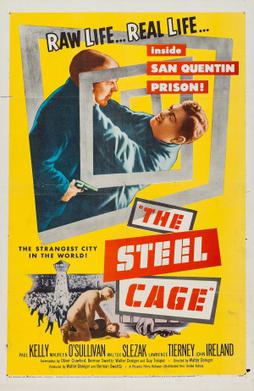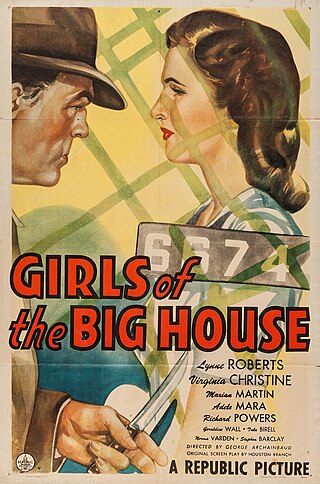
Robert Franklin Stroud, known as the "Birdman of Alcatraz", was a convicted murderer, American federal prisoner and author who has been cited as one of the most notorious criminals in the United States. During his time at Leavenworth Penitentiary, he reared and sold birds and became a respected ornithologist. From 1942 to 1959, he was incarcerated at Alcatraz, where regulations did not allow him to keep birds. Stroud was never released from the federal prison system; he was imprisoned from 1909 to his death in 1963.

Hope Emerson was an American actress, vaudevillian, nightclub performer, and strongwoman. An imposing person physically, she weighed between 190 and 230 pounds and stood 6 feet 2 inches (188 cm) tall in her prime.
The women in prison film is a subgenre of exploitation film that began in the early 20th century and continues to the present day.

Brute Force is a 1947 American crime film noir directed by Jules Dassin, from a screenplay by Richard Brooks with cinematography by William H. Daniels. It stars Burt Lancaster, Hume Cronyn, Charles Bickford and Yvonne De Carlo.
James Robson is a fictional character in the television series Oz, portrayed by R.E. Rodgers. Originally, Robson was supposed to be on for one episode and then never to be seen again. However, series creator Tom Fontana was impressed by Rodgers, so Robson became a regular from the third season to the final episode.

The Godless Girl (1928) is an American sound part-talkie dramatic directed by Cecil B. DeMille. In addition to sequences with audible dialogue or talking sequences, the film features a synchronized musical score and sound effects along with English intertitles. The soundtrack was recorded using the RCA Photophone sound-on-film system. The cast features Lina Basquette, Marie Prevost, Tom Keene and Noah Beery.

Women in Cages is a 1971 women in prison sexploitation film directed by Gerardo de León and starring Jennifer Gan, Judy Brown, Roberta Collins, and Pam Grier. Co-produced by Roger Corman, it was prominently featured in the Planet Terror portion of the 2007 film Grindhouse. Grindhouse director Quentin Tarantino said of the film, "I'm a huge, huge fan of Gerry de Leon.... the film is just harsh, harsh, harsh." He described the final shot as one of "devastating despair".

The Indiana Women's Prison was established in 1873 as the first adult female correctional facility in the country. The original location of the prison was one mile (1.6 km) east of downtown Indianapolis. It has since moved to 2596 Girls School Road, former location of the Indianapolis Juvenile Correctional Facility. As of 2005, it had an average daily population of 420 inmates, most of whom are members of special-needs populations, such as geriatric, mentally ill, pregnant, and juveniles sentenced as adults. By the end of 2015, the population increased to 599 inmates. Security levels range from medium to maximum. The prison holds Indiana's only death row for women; however, it currently has no death row inmates. The one woman under an Indiana death sentence, Debra Denise Brown, had her sentence commuted to 140 years imprisonment in 2018 and is being held in Ohio.

Convicted is a 1950 American crime film noir directed by Henry Levin and starring Glenn Ford and Broderick Crawford. It was the third Columbia Pictures film adaptation of the 1929 stage play The Criminal Code by Martin Flavin, following Howard Hawks's The Criminal Code (1930) and John Brahm's Penitentiary (1938).

Ladies They Talk About is a 1933 pre-Code American crime drama directed by Howard Bretherton and William Keighley, and starring Barbara Stanwyck, Preston Foster, and Lyle Talbot. The film is about an attractive woman who is a member of a bank-robbery gang. It is based on the play Gangstress, or Women in Prison by Dorothy Mackaye and Carlton Miles. In 1928, Dorothy Mackaye, #440960, served less than ten months of a one- to three-year sentence in San Quentin State Prison.

The Big Doll House is a 1971 American women-in-prison film starring Pam Grier, Judy Brown, Roberta Collins, Brooke Mills, and Pat Woodell. The film follows six female inmates through daily life in a gritty, unidentified tropical prison. Later the same year, the film Women in Cages featured a similar story and setting and much the same cast, and was shot in the same abandoned prison buildings. A nonsequel follow-up, titled The Big Bird Cage, was released in 1972.

The Glass Cell (1964) is a psychological thriller novel by Patricia Highsmith. It was the tenth of her 22 novels. It addresses the psychological and physical impact of wrongful imprisonment. It appeared in both the UK and the US in 1964. When first published, the book jacket carried a warning that its opening scene is "almost unacceptable".

Lady Gangster is a 1942 Warner Bros. B picture crime film directed by Robert Florey, credited as "Florian Roberts". It is based on the play Gangstress, or Women in Prison by Dorothy Mackaye, who in 1928, as #440960, served less than ten months of a one- to three-year sentence in San Quentin State Prison. Lady Gangster is a remake of the pre-Code film, Ladies They Talk About (1933). Jackie Gleason plays a supporting role.

Women in Chains is a 1972 American television film directed by Bernard L. Kowalski for ABC's Movie of the Week. The leading players are Ida Lupino, Belinda Montgomery, Lois Nettleton and Jessica Walter.

Violence in a Women's Prison is a women in prison film directed by Bruno Mattei. The film stars Laura Gemser and Gabriele Tinti. It tells the story of Emanuelle, who is sent to Santa Catarina Women's Penitentiary for drugs and prostitution, where she meets the warden and the other inmates. Her actual reason is undercover reporting for Amnesty International. It is the seventh film in the Emanuelle nera film series and the first one directed by Mattei.

Women's Prison is a 1955 American film noir crime film directed by Lewis Seiler and starring Ida Lupino, Jan Sterling, Cleo Moore, Audrey Totter, Phyllis Thaxter and Howard Duff.

The Company She Keeps is a 1951 American drama film directed by John Cromwell and starring Lizabeth Scott, Jane Greer and Dennis O'Keefe. It was produced and distributed by RKO Pictures. Cromwell's film of the previous year, Caged, also concerned a woman sent to prison. It marked Jeff Bridges' film debut.

The Steel Cage is a 1954 American film noir drama film directed by Walter Doniger, written by Oliver Crawford, Walter Doniger, Scott Littleton, Berman Swarttz and Guy Trosper, and starring Paul Kelly, Maureen O'Sullivan, Walter Slezak, John Ireland, Lawrence Tierney and Arthur Franz. It was released in December 1954, by United Artists.

Girls of the Big House is a 1945 American drama film directed by George Archainbaud and starring Lynne Roberts, Virginia Christine and Marion Martin.

Caged is a 2020 American drama film directed by Aaron Fjellman and starring Edi Gathegi, Melora Hardin, Angela Sarafyan and Tony Amendola. Fjellman co-wrote the screenplay with James 'Doc' Mason. The film was produced by Pete Kirtley, Aaron Fjellman, Matthew Temple and Jessa Zarubica.



















